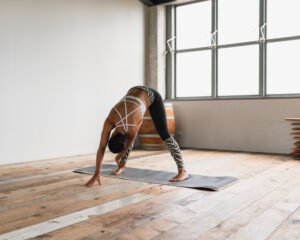
If you’re new to Pilates, embarking on your journey with a step-by-step guide can be incredibly helpful. Pilates is a versatile and effective form of exercise that focuses on core strength, flexibility, and body awareness. In this article, we will walk you through the basics of Pilates exercises for beginners, including how to get started, the best types of Pilates for beginners, and how to practice Pilates at home.
How to do Pilates step by step?
Pilates exercises can be broken down into a series of steps to ensure proper form and execution. Here’s a step-by-step guide on how to do Pilates exercises:
1. Warm-up: Begin your Pilates session with a brief warm-up to prepare your body for exercise. This can include gentle movements like shoulder rolls, neck stretches, and a few minutes of light cardio to increase blood flow.
2. Find your alignment: Stand tall with your feet hip-width apart, shoulders relaxed, and spine lengthened. Engage your core muscles by drawing your navel towards your spine. This alignment is important for maintaining stability throughout the exercises.
3. Breathing: Practice deep, diaphragmatic breathing throughout your Pilates session. Inhale deeply through your nose, expanding your ribcage, and exhale fully through your mouth, drawing your navel in towards your spine. Coordinate your breath with the movements for a fluid and controlled practice.
4. Start with foundational exercises: Begin with basic Pilates exercises that focus on core activation and stability. Examples include pelvic curls, leg circles, or the hundred. Pay attention to proper form, maintaining control, and engaging the correct muscles.
5. Progress to more challenging exercises: As you gain strength and confidence, gradually incorporate more advanced Pilates exercises into your routine. This may include exercises on the Pilates reformer, such as the footwork or the long stretch. Always listen to your body and progress at a pace that feels comfortable for you.
6. Cool down and stretch: Complete your Pilates session with a cool-down phase to lower your heart rate and stretch your muscles. Gentle stretches targeting the muscles you worked during the session, such as the hamstrings, hip flexors, and shoulders, can help reduce muscle soreness.
How do beginners start Pilates?
If you’re a beginner starting Pilates, it’s important to approach it with patience and a focus on building a solid foundation. Here are some tips to help you get started:
1. Find a qualified instructor: Consider taking classes or working with a certified Pilates instructor who can guide you through the proper techniques and ensure your safety. They can provide personalized instruction and modifications tailored to your fitness level.
2. Start with a beginner-friendly class: Look for Pilates classes specifically designed for beginners. These classes typically introduce foundational exercises, teach proper form, and gradually progress in difficulty.
3. Take it slow and listen to your body: Don’t rush into advanced exercises. Focus on understanding the basic principles of Pilates and gradually build your strength and proficiency. Pay attention to your body’s feedback and modify exercises as needed to avoid strain or injury.
4. Be consistent: Consistency is key in any exercise program. Aim to practice Pilates regularly, whether it’s attending classes or following online tutorials. Consistent practice will help you improve and see progress over time.
Which type of Pilates is best for beginners?
When starting Pilates as a beginner, it’s advisable to begin with mat-based Pilates. Mat Pilates utilizes body weight and simple props like resistance bands and small balls to perform exercises. This form of Pilates is accessible and can be done anywhere, making it ideal for beginners. Mat-based classes often focus on core strength, flexibility, and alignment, providing a solid foundation for your Pilates journey.
How do you do Pilates at home for beginners?
Practicing Pilates at home as a beginner is convenient and can be just as effective as attending classes. Here are some steps to do Pilates at home for beginners:
1. Create a dedicated space: Set up a clean and clutter-free area where you can comfortably perform your Pilates exercises. Use a mat or a soft surface to cushion your body.
2. Follow online tutorials or videos: There are numerous online resources, including websites and video platforms, offering guided Pilates workouts for beginners. Find reputable sources with clear instructions and demonstrations to ensure you’re following proper form and technique.
3. Start with beginner-level workouts: Look for Pilates workouts specifically designed for beginners. These workouts will focus on foundational exercises and gradually introduce more challenging movements as you progress.
4. Be mindful of your body’s limitations: As a beginner, it’s important to listen to your body and avoid pushing beyond your comfort level. Modify exercises as needed and take breaks if necessary. Remember to prioritize proper form and technique over quantity or intensity.
In summary, Pilates exercises for beginners can be approached step by step. Starting with a warm-up, focusing on alignment, breathing, and foundational exercises, beginners can gradually progress to more challenging movements. Finding a qualified instructor, starting with mat-based Pilates, and practicing consistently are key considerations for beginners. Additionally, practicing Pilates at home can be achieved by creating a suitable space, following online tutorials, and being mindful of personal limitations. By following these guidelines, beginners can embark on their Pilates journey with confidence and reap the benefits of improved strength, flexibility, and body awareness.